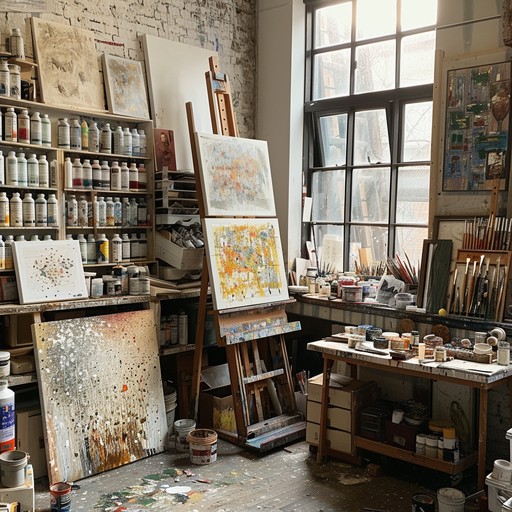
“Insights and Perspectives from the Artist’s Easel”

**The Artistic Evolution of Spaces: Cultivating Creativity in Studio Work**
When we think of art, we often envision the finished product—a portrait hanging in a gallery, a striking sculpture, or a captivating digital animation. But behind every masterpiece lies a workspace—a studio where the artist’s imagination takes shape. Studios not only serve as functional spaces but also reflect the creative journeys and evolving practices of the artists who occupy them. In this article, we explore the intimate connections between artists and their studios, showcasing how these spaces become sanctuaries for inspiration, experimentation, and growth.
—
### **Turning Spaces into Creative Sanctuaries**
From Santa Fe gardens to bustling Tribeca streets, artists draw profound inspiration from their surroundings. Studios, whether large or small, bare or fully equipped, act as incubators of imagination. They are places where artists can test boundaries, confront challenges, and embrace failures. The workspace becomes both a canvas and a collaborator, shaping not only what the artist creates but also how they create it.
For many artists, a studio is more than a physical location—it’s a relationship. As one artist describes, being surrounded by their work in the studio feels “like being surrounded by children—it brings immense joy, but also a restless responsibility.” The studio becomes a mirror of the artist’s emotional and creative process, offering both solace and provocation.
—
### **Daily Routines: Building Momentum in the Studio**
Artistic work thrives on rhythm, even when it appears spontaneous. For some artists, an average day in the studio starts slowly, easing into the zone with familiar rituals. A stroll by the river, a warm thermal mug of tea, or even the calming presence of a pet (like Moka, the lovable studio dog) can help transition from the outside world into the focused realm of creation.
While routines provide structure, the creative process often includes moments of stillness and frustration. Conceptualizing, for instance, can mean hours of staring into space, flipping through sketches, or even abandoning the studio for a walk in the garden to reset. “Sometimes, I sit there for hours and nothing happens,” shares one artist. “But stepping away for unrelated activities helps re-groove my brain.”
Experimentation plays a crucial role, whether it’s integrating digital tools, testing new painting techniques, or working with unconventional materials like paper clay. For these creators, the joy lies in embracing the unpredictability of their medium, from the fast pace of digital edits to the slow and meditative process of watching paint dry.
—
### **Environmental Influence: The Studio as a Living Organism**
The environment surrounding a studio often seeps its essence into the artist’s work. For some, this comes through the inspiration of seasons and nature. A studio nestled in Santa Fe, for instance, is not just a room—it’s connected to a lush garden offering fresh air and natural patterns to incorporate into one’s work. The plants and landscapes that emerge in these pieces are inseparable from the environment where they were conceived.
In urban centers like Tribeca, studios serve as hubs for interaction and collaboration. Events like open studio nights bring artists face-to-face with visitors, allowing for feedback and shared inspiration. These interactions breathe life into solitary practices, fostering a sense of community essential to the artist’s growth.
—
### **Balancing the Studio’s Strengths and Limitations**
No studio is perfect. As much as artists may love their creative spaces, they often find themselves wishing for something more. A smaller studio, for example, may hinder large-scale projects but teach resourcefulness. Similarly, a spacious studio may inspire grand ideas but create pressure to produce continuously.
Time, too, is a constraint. Many artists dream of hosting casual events to connect with the community but find it challenging to balance such ambitions with the demands of their work. This tension reflects the perpetual push-and-pull of being both creator and steward of a space.
—
### **Materials: Bridging Fast and Slow Processes**
Art materials carry deeply personal significance, serving as extensions of the artist’s vision. Some creators feel at home with digital mediums, which allow rapid prototyping and immediate feedback. Others find grounding in tactile processes like painting, where the slow rhythms of mixing, layering, and drying provide a counterbalance to the digital world’s speed.
For many, the intersection of fast and slow mediums sparks innovation. One artist describes this equilibrium: “There’s something deeply satisfying about paint—it’s grounding. But working with digital materials lets us test ideas quickly. We feel most at ease positioned between these two realms.”
—
### **The Studio as a Reflection of the Artist**
Perhaps the most fascinating aspect of the studio is how it evolves alongside the artist. As years pass, ambitions shift, and materials change, the studio becomes a living testament to the artist’s journey. Some studios remain consistent for decades, becoming infused with memories, while others are temporary—a year-long stint in a rent-free program, for example—offering a fleeting